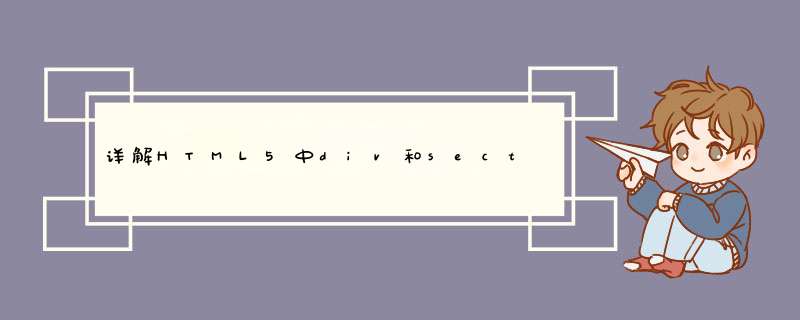
刚刚开始接触 HTML5 时,对它的标签很不适应,甚至一度有点反感。
尤其是对 div、section、article 这几个标签,实在弄不清楚应该使用在什么场合下。
div
HTML Spec:
The div element has no special meaning at all.
这个标签是我们见得最多、用得最多的一个标签。
本身没有任何语义,用作布局以及样式化或脚本的钩子(hook)。
section
HTML Spec: “The section element represents a generic section of a document or application. A section, in this context, is a thematic grouping of content, typically with a heading.”
与 div 的无语义相对,简单地说 section 就是带有语义的 div 了,但是千万不要觉得真得这么简单。
section 表示一段专题性的内容,一般会带有标题。
看到这里,我们也许会想到,那么一篇博客文章,或者一条单独的评论岂不是正好可以用 section 吗?接着看:
Authors are encouraged to use the article element instead of the section element when it would make sense to syndicate the contents of the elemen.
当元素内容聚合起来更加言之有物时,应该使用 article 来替换 section 。
那么,section 应该什么时候用呢?再接着看:
Examples of sections would be chapters, the various tabbed pages in a tabbed dialog box, or the numbered sections of a thesis. A Web site’s home page could be split into sections for an introduction, news items, and contact information.
section 应用的典型场景有文章的章节、标签对话框中的标签页、或者论文中有编号的部分。
一个网站的主页可以分成简介、新闻和联系信息等几部分。
其实我对这里传达信息很感兴趣,因为感觉 section 和下面要介绍的 artilce 更加适用于模块化应用,这个话题以后会出篇专门的文章来讨论,这里暂时略过。
要注意,W3C 还警告说:
The section element is not a generic container element. When an element is needed for styling purposes or as a convenience for scripting, authors are encouraged to use the div element instead. A general rule is that the section element is appropriate only if the element’s contents would be listed explicitly in the document’s outline.”
section 不仅仅是一个普通的容器标签。
当一个标签只是为了样式化或者方便脚本使用时,应该使用 div 。
一般来说,当元素内容明确地出现在文档大纲中时,section 就是适用的。
- <article>
- <hgroup> <h1>Apples</h1> <h2>Tasty, delicious fruit!</h2> </hgroup>
- <p>The apple is the pomaceous fruit of the apple tree.</p>
- <section>
- <h1>Red Delicious</h1>
- <p>These bright red apples are the most common found in many supermarkets.</p>
- </section>
- <section>
- <h1>Granny Smith</h1>
- <p>These juicy, green apples make a great filling for apple pies.</p>
- </section>
- </article>
article
HTML Spec:
The article element represents a self-contained composition in a document, page, application, or site and that is, in principle, independently distributable or reusable, e.g. in syndication.
article 是一个特殊的 section 标签,它比 section 具有更明确的语义, 它代表一个独立的、完整的相关内容块。
一般来说, article 会有标题部分(通常包含在 header 内),有时也会 包含 footer 。
虽然 section 也是带有主题性的一块内容,但是无论从结构上还是内容上来说,article 本身就是独立的、完整的。
HTML Spec 中接着又列举了一些 article 适用的场景。
This could be a forum post, a magazine or newspaper article, a blog entry, a user-submitted comment, an interactive widget or gadget, or any other independent item of content.
当 article 内嵌 article 时,原则上来说,内部的 article 的内容是和外层的 article 内容是相关的。
例如,一篇博客文章中,包含用户提交的评论的 article 就应该潜逃在包含博客文章 article 之中。
问题是怎么才算“完整的独立内容”?有个最简单的判断方法是看这段内容在 RSS feed 中是不是完整的。
看这段内容脱离了所在的语境,是否还是完整的、独立的。
例子:
XML/HTML Code复制内容到剪贴板- <article>
- <header>
- <h1>The Very First Rule of Life</h1>
- <p><time pubdate datetime="2009-10-09T14:28-08:00"></time></p>
- </header>
- <p>If there's a microphone anywhere near you, assume it's hot and sending whatever you're saying to the world. Seriously.</p>
- <p>...</p>
- <footer>
- <a href="?comments=1">Show comments...</a>
- </footer>
- </article>
- <article>
- <header>
- <h1>The Very First Rule of Life</h1>
- <p><time pubdate datetime="2009-10-09T14:28-08:00"></time></p>
- </header>
- <p>If there's a microphone anywhere near you, assume it's hot and sending whatever you're saying to the world. Seriously.</p>
- <p>...</p>
- <section>
- <h1>Comments</h1>
- <article>
- <footer>
- <p>Posted by: George Washington</p>
- <p><time pubdate datetime="2009-10-10T19:10-08:00"></time></p>
- </footer>
- <p>Yeah! Especially when talking about your lobbyist friends!</p>
- </article>
- <article>
- <footer>
- <p>Posted by: George Hammond</p>
- <p><time pubdate datetime="2009-10-10T19:15-08:00"></time></p>
- </footer>
- <p>Hey, you have the same first name as me.</p>
- </article>
- </section>
- </article>
总结
div section article ,语义是从无到有,逐渐增强的。
div 无任何语义,仅仅用作样式化或者脚本化的钩子(hook),对于一段主题性的内容,则就适用 section,而假如这段内容可以脱离上下文,作为完整的独立存在的一段内容,则就适用 article。
原则上来说,能使用 article 的时候,也是可以使用 section 的,但是实际上,假如使用 article 更合适,那么就不要使用 section 。
nav 和 aside 的使用也是如此,这两个标签也是特殊的 section,在使用 nav 和 aside 更合适的情况下,也不要使用 section 了。
对于 div 和 section、 article 以及其他标签的区分比较简单。
对于 section 和 article 的区分乍看比较难,其实重点就是看看这段内容脱离了整体是不是还能作为一个完整的、独立的内容而存在,这里面的重点又在完整身上。
因为其实说起来 section 包含的内容也能算作独立的一块,但是它只能算是组成整体的一部分,article 才是一个完整的整体。
因为其实有些时候每个人都有自己的看法,所以难免有难于决断的时候,怎么办?
在 HTML5 设计原理 中,有一条是专门用来解决类似情况的:
最终用户优先(Priority of Constituencies)
“In case of conflict, consider users over authors over implementors over specifiers over theoretical purity.” 一旦遇到冲突,最终用户优先,其次是作者,其次是实现者,其次标准制定者,最后才是理论上的完满。
推荐各位多读几遍 HTML5 设计原理,这才是纷繁世界背后的最终奥义。
欢迎分享,转载请注明来源:内存溢出

 微信扫一扫
微信扫一扫
 支付宝扫一扫
支付宝扫一扫
评论列表(0条)